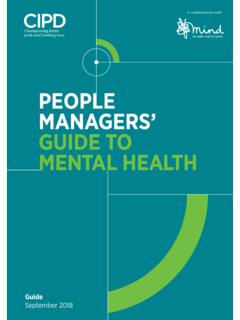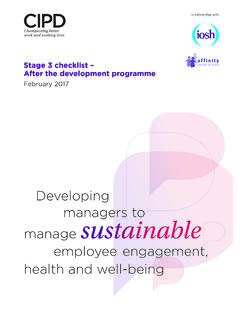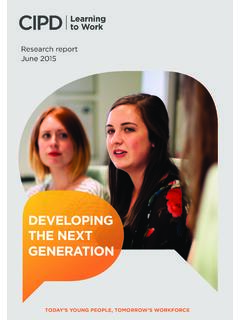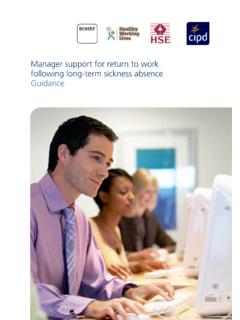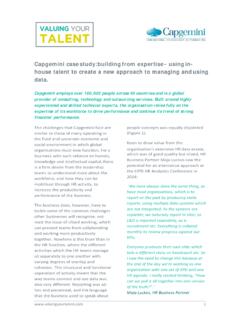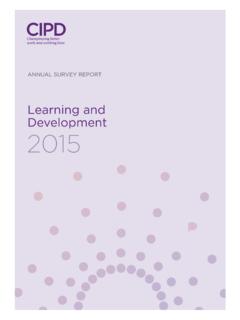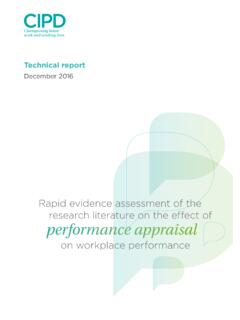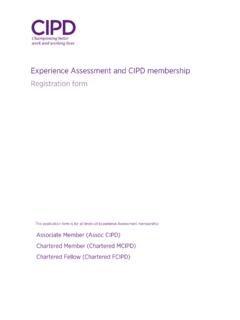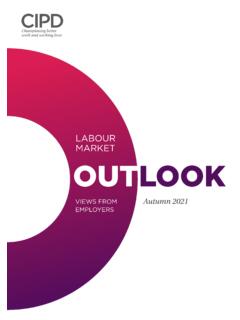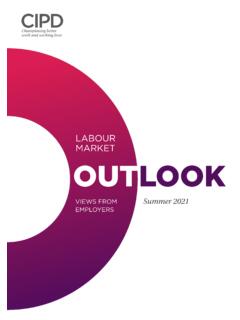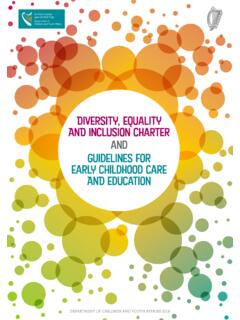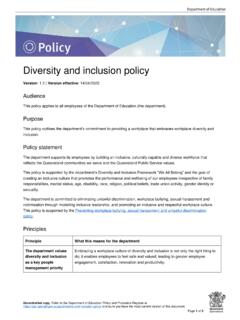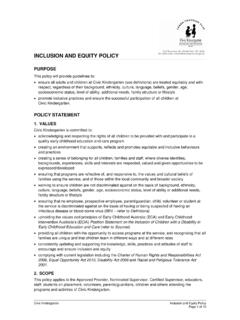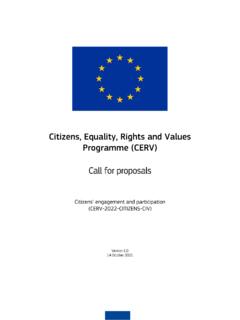Transcription of Diversity and Inclusion at Work - CIPD
1 Summary report June 2018 Facing up to the business case The CIPD is the professional body for HR and people development. The not-for-profit organisation champions better work and working lives and has been setting the benchmark for excellence in people and organisation development for more than 100 years. It has more than 145,000 members across the world, provides thought leadership through independent research on the world of work, and offers professional training and accreditation for those working in HR and learning and and Inclusion at work: facing up to the business caseAcknowledgementsThis report was written by Mel Green, Heather Bond, Jill Miller and Jonny Gifford of the would also like to thank Barbara Janssen for her guidance and assisting in the critical appraisal phase of the rapid evidence assessment that forms the basis of this research reportDiversity and Inclusion at work: facing up to the business caseContents Introduction 2 What are the outcomes of Diversity ?
2 3 What factors keep inequality in place at work? 5 What supports greater Inclusion and Diversity in the workplace? 6 Diversity and Inclusion at work: where to next? 7 References 92 Diversity and Inclusion at work: facing up to the business case1 IntroductionDespite equality legislation and a recognition by many organisations that Diversity and Inclusion is important, we know that inequality still exists in the workplace. For example, in the UK, gender pay gap reporting has shone a light on the structural barriers to progression in organisations for women, including a lack of senior role models and flexible working. Positively, Diversity and Inclusion is rising up the agenda in many organisations. However, the pace of progress towards realising equality of opportunity is still painfully slow. We need more evidence of what works to help guide organisations efforts and galvanise action to remove barriers to moral case for Diversity and inclusionThere is a compelling moral case for Diversity and Inclusion in the workplace and beyond.
3 Ensuring everyone is treated equally, with dignity and has their fair share of resources (whether that be access to work or equitable pay) is simply the right thing to do. People matter, and we all should have equal opportunity to develop, progress, and be rewarded and recognised at work. Organisations must ensure that their people management practices champion this fundamental principle. People matter, and we all should have equal opportunity to develop, progress, and be rewarded and recognised at work. Organisations must ensure that their people management practices champion this fundamental principle. The business case for Diversity and inclusionThere is also still the need to provide a financially driven business case for action for some business leaders (although the moral case should be sufficient). This business case for Diversity focuses on what Diversity can do for organisational performance, built on the widely accepted belief that Diversity and Inclusion yields positive performance outcomes for organisations.
4 However, it is important to understand the relationship between Diversity and performance, and under what conditions Diversity can lead to positive outcomes. And, by being inclusive and supporting Diversity , organisations (and importantly, the individuals within them) may benefit in a variety of ways that are not typically measured, such as retention of diverse talent, employee satisfaction and well-being. This research aims to uncover the evidence behind the business case argument, while highlighting that there is a need to challenge this traditional notion of the business case that focuses only on financial, rather than human, outcomes and other business outcomes such as corporate reputation. Despite an often over-reliance of business leaders and default focus on the narrow business case, we argue that any business case for Diversity should hold these outcomes in balance and recognise the benefits at not only an organisational level but from an individual and societal perspective.
5 We believe the people profession must champion a progressive perspective on the creation of value that considers a broad range of stakeholders and challenges a narrow focus on maximising shareholder value (CIPD 2018). Introduction3 Diversity and Inclusion at work: facing up to the business caseWhat are the outcomes of Diversity ?Limited progress and a lack of evidenceIt is evident that people management practices, alongside the culture and values of an organisation, hold the key to unlocking truly inclusive working practices that add value beyond compliance with equality legislation. People professionals have a key part to play in ensuring that what is espoused in policies is acted out in practice, ensuring fairness and encouraging diverse voices to be heard. Unfortunately, while many organisations prioritise Diversity and Inclusion , action is often not guided by clear knowledge of what works, and under what conditions. We need this knowledge to take informed, evidence-based summary outlines the key findings of our research report Diversity and Inclusion at Work: Facing up to the business case.
6 This research uses a rapid evidence assessment methodology of the scientific literature to answer three questions: what are the outcomes of Diversity and Inclusion , what factors keep inequality in place, and what supports greater Inclusion and Diversity in the workplace? Alongside this, we highlight implications for policy1 and key actions for people professionals. Further discussion of the findings of this research and their implications for Diversity and Inclusion at work can be found in the full report, found at What are the outcomes of Diversity ?Our evidence assessment identified a vast amount of literature on the outcomes of Diversity on various aspects of organisational performance but very little on the outcomes for employees. Most studies are meta-analyses of multiple research findings that are cross-sectional or longitudinal in nature, meaning the relationship between Diversity and outcomes should be seen as an association, rather than a proven causal relationship.
7 Little research on Inclusion outcomes for employees or organisations of appropriate methodology was found in our search, although arguably this is key to unlock the potential of Diversity (Nishii 2013). We therefore focus on Diversity findings Diversity is a broad term and different aspects of Diversity have different effects on outcomes: For example, team tenure is associated with efficiency, but not creativity, whereas cultural Diversity has been associated with creativity (Bell et al 2011, Stahl et al 2010). There is conflicting evidence that Diversity of demographic factors such as gender, age and ethnicity are associated with positive team performance. Effects of Diversity on performance are moderated by aspects of the organisation context, such as industry and inclusiveness of the organisation climate (Joshi and Roh 2009). Research examines the relationship between Diversity and organisation-level outcomes (for example financial performance or team performance) but has largely neglected individual-level outcomes such as well-being and employee satisfaction.
8 Research tends to focus on a small number of characteristics (such as gender) and discrete outcomes, such as team performance. 1 We reference implications for UK policy, although the research base we discuss draws on international and Inclusion at work: facing up to the business caseWhat are the outcomes of Diversity ? This approach to research means that intersectionality that we all have multiple, overlapping identities is rarely a feature in this literature. Research focuses on sole protected characteristics, so does not consider individual differences in the round for example, how the experience of a white man differs from a black for policy 1 The lack of research on intersectionality the fact we all have multiple identities and they overlap highlights the need for a more holistic view of Diversity . While it is important to focus policy on specific issues, this should not be to the detriment of the wider picture.
9 For example, in his report into the ethnic Diversity of UK boards, Sir John Parker concludes that, It is clear that the recent emphasis on gender Diversity in the UK Boardroom has not benefited women of colour to the same extent as it has women who are not ethnic minorities. Of the appointments made following the Davies Review, a relatively small number of those Board positions have gone to women of colour (Parker 2016, p21). 2 Questions about intersectionality have come to the fore in discussions about pay gap reporting. The focus so far has been on gender pay gap reporting, but with the possibility of race pay gap reporting (proposed by Baroness Ruby McGregor-Smith (2017) in her independent review of race in the workplace). It is as yet unclear how reporting on the two dimensions of Diversity could sit together. Implications for people professionals 1 Intersectionality is important to understand team processes; we all have multiple identities that influence how we interact with others.
10 People professionals need to be mindful that a focus on one group, for example women, may not benefit everyone within that group. Other characteristics will affect the opportunities people are given at work. 2 People professionals should be mindful of the lack of conclusive evidence for the Diversity business case , with both positive and negative outcomes of diverse teams being a possibility. The case for Diversity must be a holistic one, taking into account the benefits of Diversity for organisations (such as enhanced employer brand, contribution to society, and corporate reputation) alongside the benefits for individuals at work. 3 Context is important to understand where diverse teams may be challenged for example, in male-dominated industries or regions where gender parity is low, gender-diverse teams may have specific challenges. People professionals must be aware of the context their organisation operates in, and adapt their approach accordingly.
